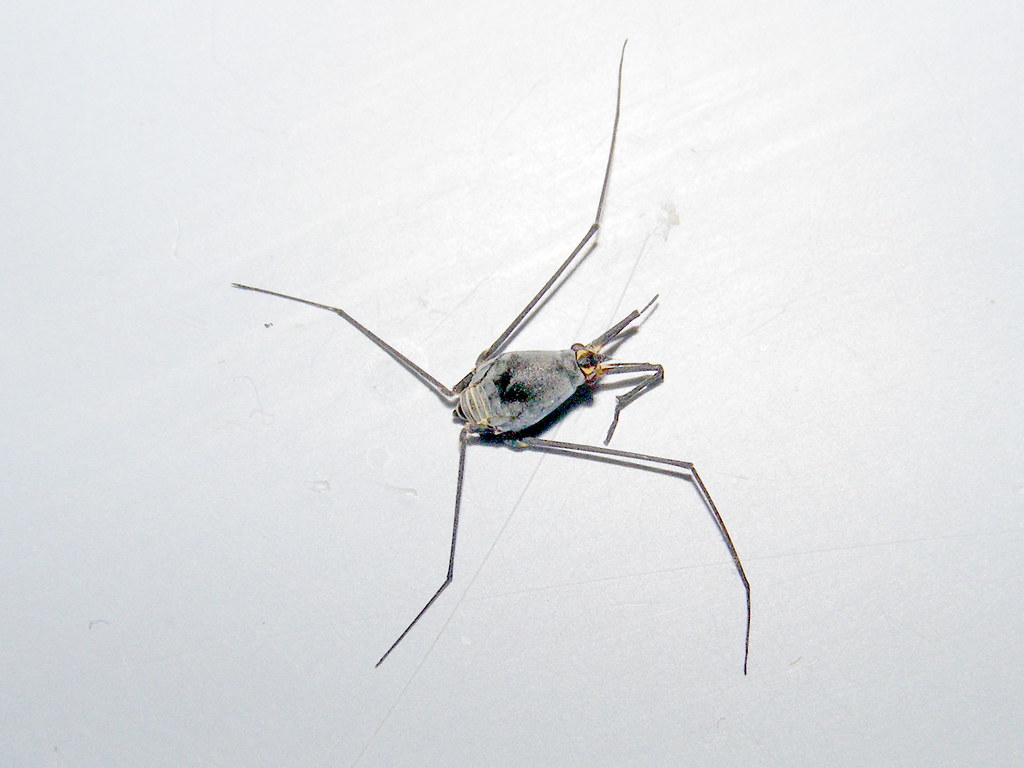#insect biodiversity
Text

Giant Malaysian leaf insect
Carpenter ant?
Royal Goliath beetle
Blue Dasher
Polyphemus moth
Goliath stick insect
Two-spot lady bird
Harlequin ladybird
Rhetenor blue morph butterfly
Monarch butterfly chrysalis
Colorado potato beetle?
Luna moth caterpillar?
Some kind of katydid?
#charley harper#insect world#insect biodiversity#animal identification#idk folks it's hard to ID a brown ant#insects: not my strong suit
6 notes
·
View notes
Text
Insects are critical to the survival of most other animals, including humans. But many insect species, from beetles to dragonflies to butterflies, are declining in abundance due in part to human activity. For Earth Month, Insectarium host Dr. Jessica L Ware gives tips on small things each of us can do to make a lasting impact and help insects thrive for years to come.
Learn more about insects with Museum Curator Jessica Ware in Insectarium on PBS Terra's YouTube channel.
#science#amnh#museum#natural history#nature#animals#insects#bugs#entomology#conservation#biodiversity#earth day#earth month
662 notes
·
View notes
Text
I see at least one cool bug a day, and usually many more, but it’s not because I live anywhere particularly rich in strange, wonderful creatures (I live in an unremarkable corner of Pennsylvania, USA) or spend all of my free time looking for bugs (well, just *most* of it). in my experience, finding interesting bugs is less about actually locating them and more about looking closely at tiny things you’d otherwise ignore!
this very long post was compiled over a couple days in late July, although I spent less than 10 minutes at a time searching. there’s a lot of fun creatures just out in the open.

plants are always a good place to start when looking for bugs, and I chose this small fig tree (Ficus carica) with a mulberry sapling friend. feeding on the sap of the fig and mulberry is the first group I’ll take a look at, the planthoppers:

these two are flatid bugs, Metcalfa pruinosa and Flatormenis proxima. flatids are slow-moving bugs that can be approached closely, but once they get tired of circling around stems to avoid you they may launch themselves into a fluttering flight with spring-loaded rear legs.
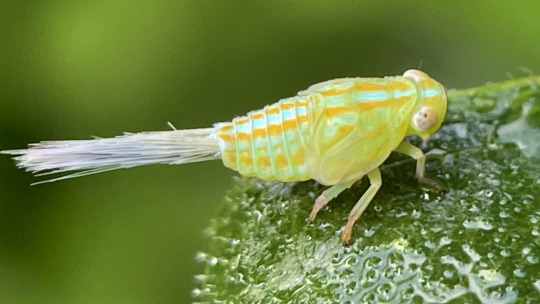
Aplos simplex, a member of the related family Issidae, also likes fig sap. its “tail” is actually a tuft of waxy secretions, which get shed along with the bright colors when it assumes a lumpy, bean-shaped adult form.
cicadellids, or leafhoppers, are just about everywhere on plants, but can be hard to approach without scaring them.


Agallia constricta on the left is a tiny species that feeds on grass, but many were scared up onto the fig by my footsteps. Jikradia olitoria is a much larger species that does feed on the fig; juveniles like this are curled, creeping goblins while adults’ rounded wings give them a pill-shaped appearance.

this big, pale leafhopper belongs to genus Gyponana. it’s tricky to get to species ID with these.
Graphocephala are striking little hoppers that eat a variety of native and nonnative plants. G. coccinea is the larger, more boldly colored one and G. versuta is smaller but more common locally. they’ll sit on the tops of leaves but take flight if you get too close quickly.
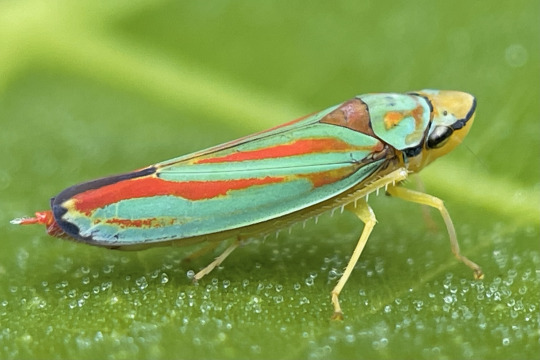
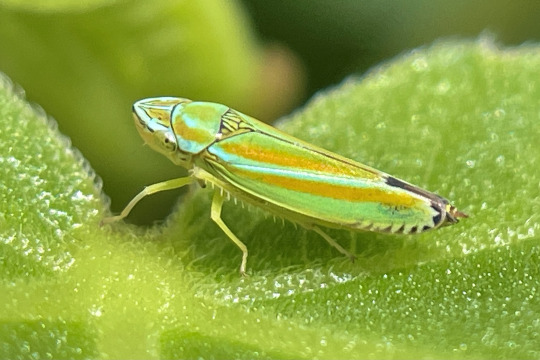
another group you’re almost guaranteed to encounter are flies (Diptera). these are a very diverse group, so much more than houseflies and mosquitoes (though I did run into both)
where I live, any plant with broad leaves is almost guaranteed to have a few Condylostylus, long-legged flies that come in shades of blue, green, and red. despite their dainty physique, they’re agile predators, typically feeding on other small flies.
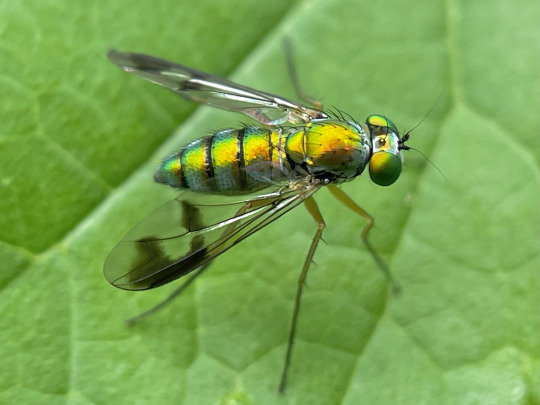
next, a few hoverflies: the ubiquitous Toxomerus geminatus and a Eumerus that I’ve been seeing a lot of this year (but maybe I’ve just noticed them for the first time). syrphids have varied life histories, but most adults drink nectar and many of the larvae are predaceous on aphids.
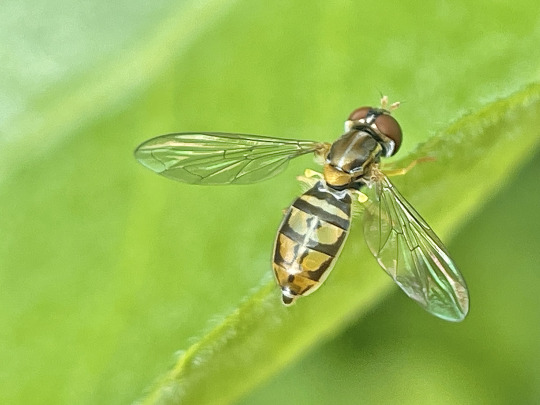
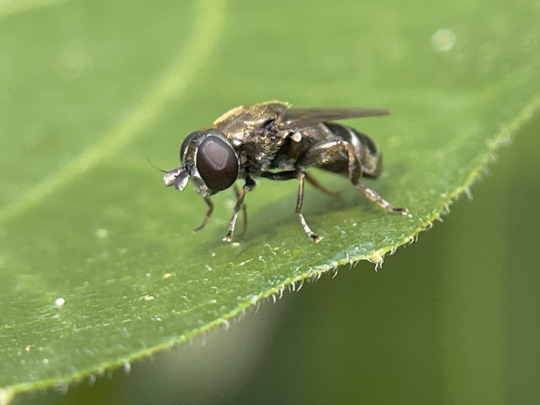
the metallic green soldier fly is Microchrysa flaviventris, nonnative here. Coenosia is a fun example of a “fly that looks like a fly,” with big red eyes and a gray body, and you might think they’re just another dung-sucking pest, but they’re actually aggressive predators! this one seemed to have nabbed itself some sort of nematoceran fly, maybe a fungus gnat.
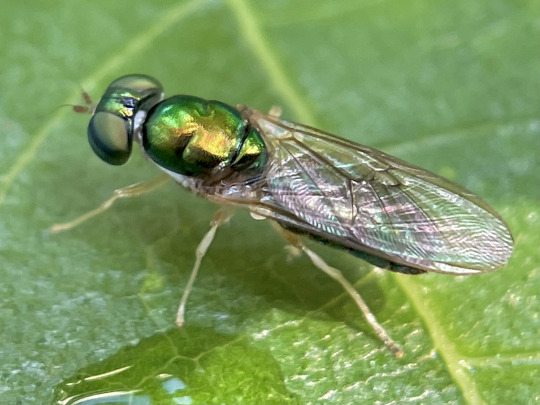

many flies are very tiny, just millimeters long. the first two little fellows are lauxaniids, while the last one, an agromyzid leafminer Cerodontha dorsalis, burrows through grass leaves as a larva.
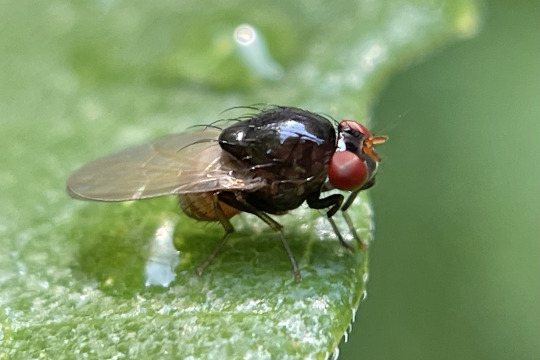
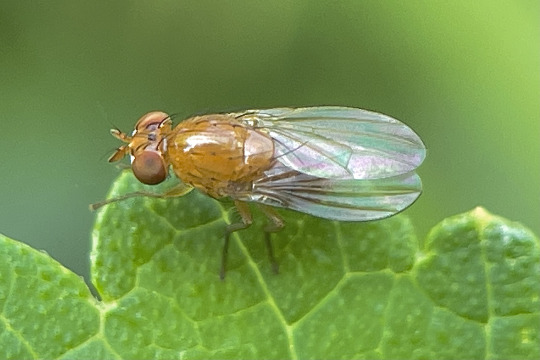

while moths and butterflies (Lepidoptera) are drawn to plants for their flowers or to lay eggs, many small moths can easily be found resting on or under leaves during the day.
these first two are tortricids, many of which are flat, rectangular moths resembling chips of bark or dead leaves. the apple bud moth, Platynota idaeusalis, feeds on a wide variety of hosts, while this beat-up old Argyrotaenia pinatubana would have developed in an edible tube nest of pine needles.


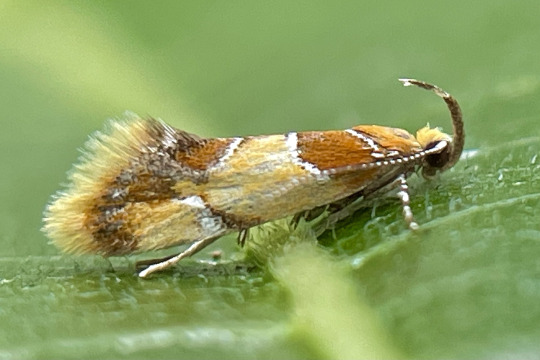
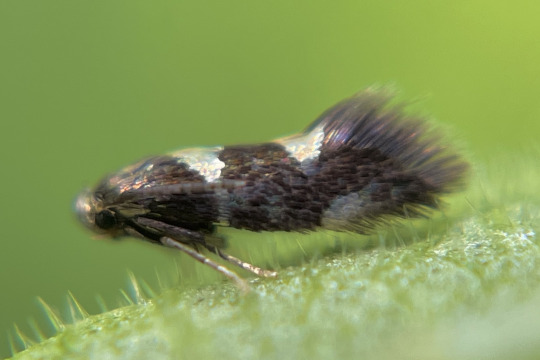
Callima argenticinctella feeds in bark and dead wood (a resource used by more caterpillars than you’d realize!) while the last moth, possibly an Aspilanta, is a leafminer.
although beetles (Coleoptera) are famous for their diversity, I didn’t find too many on the fig. the invasive Oriental beetle Exomala orientalis resting here can be found in a wide range of colors, from this common tan to to deep iridescent black. the other beetle is a Photinus pyralis firefly, sleeping under leaves as fireflies do.
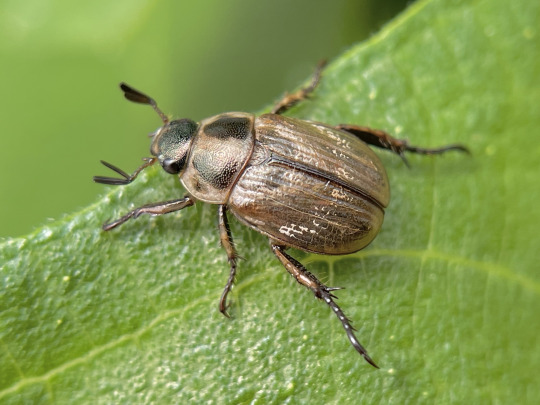

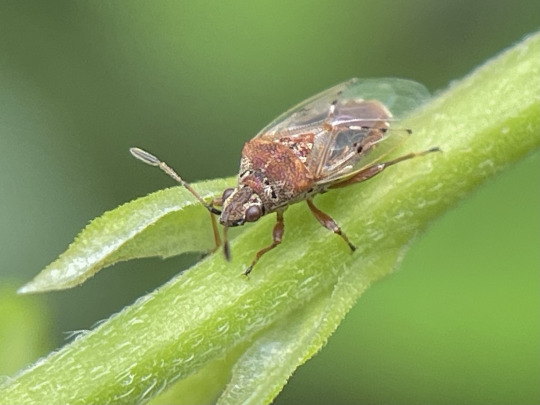
a few spare hemipterans: a Kleidocerys resedae that blew in on a wind, and below, the mulberry whitefly Tetraleurodes mori feeds on its namesake host. as for Hymenoptera, I saw manny tiny parasitic braconid wasps and various ants attracted to the planthoppers’ honeydew excretions—always worth checking underneath roosting hoppers for things having a drink.

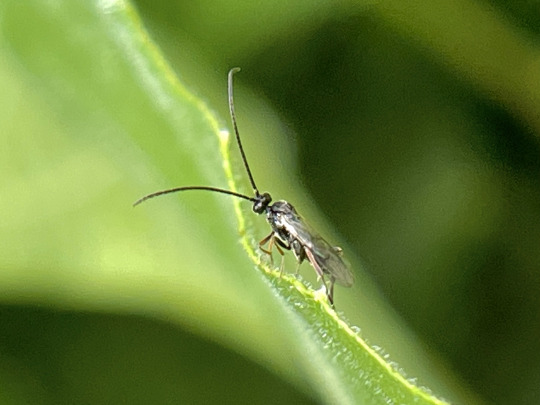
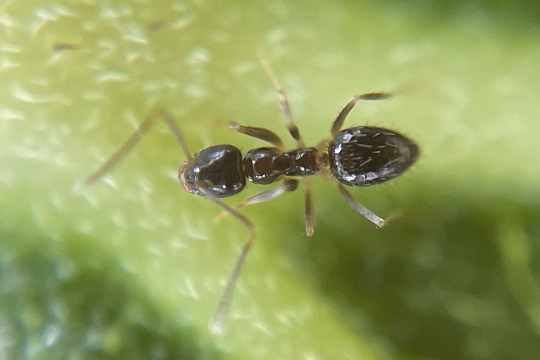
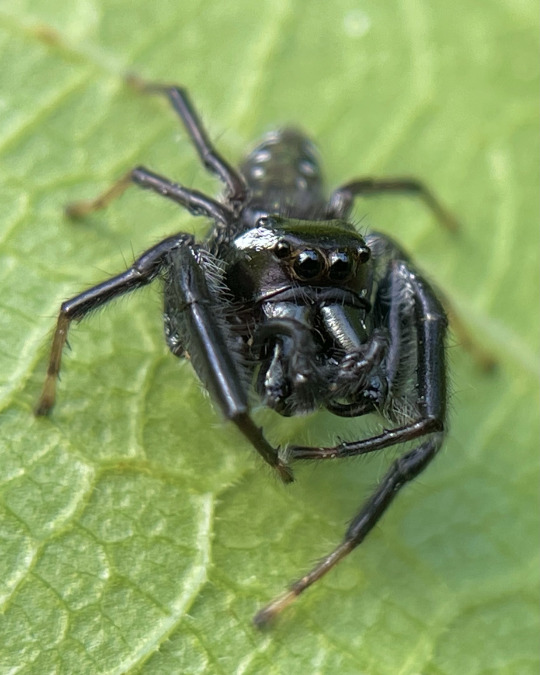
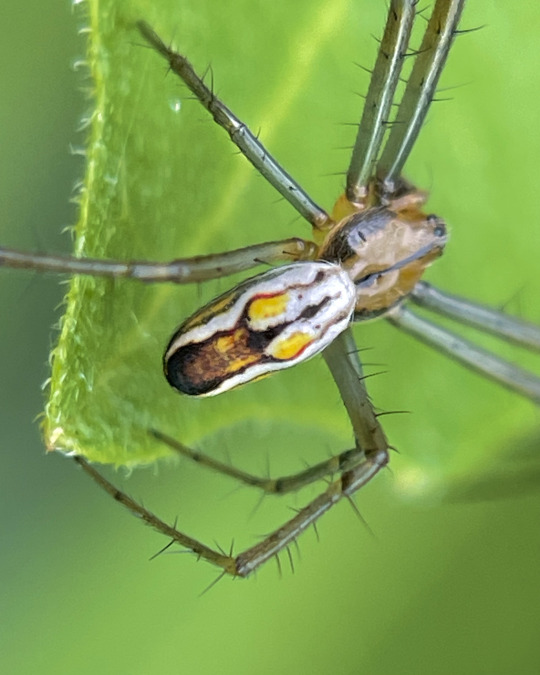
a couple handsome spider boys were scrambling through the fig seeking females, a jumping spider Paraphidippus aurantius and an orbweaver, Mecynogea lemniscata.
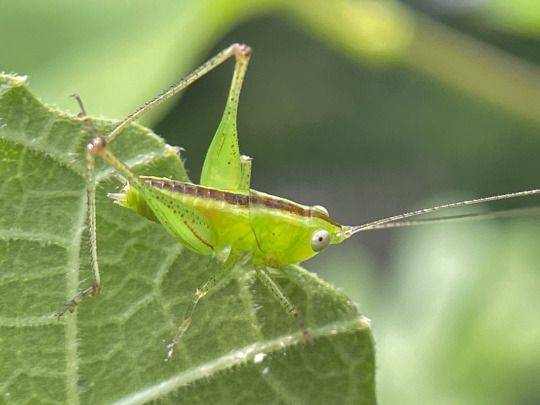
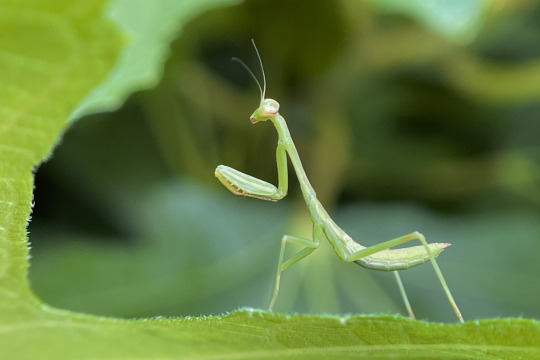
and to round it off, a young Conocephalus meadow katydid and a Carolina mantis, Stagmomantis carolina.
there’s 31 species of arthropod in this post, and I probably saw some 45, not all of which stayed for photos. if you walk slowly and look closely, you can see a sizeable chunk of your local biodiversity in under fifteen minutes! of course this will depend on where you live and what time of year it is, but there’s almost always more cool bugs out there than you’d expect, even on just a single plant.
1K notes
·
View notes
Text

Tiny perfect treehoppers. These studies were drawn from specimens in a beautiful piece by Fukui Keiki in Tokyo.
#treehopper#insect#insect art#animal art#artists on tumblr#sketches#art#drawing#traditional art#pen#ink#bug#entomology#biodiversity
421 notes
·
View notes
Text
How Non-Native Plants Are Contributing to a Global Insect Decline
The impact of introduced plants on native biodiversity has emerged as a hot-button issue in ecology. But recent research provides new evidence that the displacement of native plant communities is a key cause of a collapse in insect populations and is affecting birds as well...
#non-native plants#invasive species#environment#conservation#insect decline#insect#insects#entomology#biodiversity#animals#nature#botany#plants#non-native invasive species
1K notes
·
View notes
Text
This is very exciting news indeed! The dark bordered beauty moth (Epione vespertaria) is found across Europe, but in Britain its habitat has been so reduced that it is now only found in three small areas in Scotland. Intensive captive breeding efforts starting last year led to a release of 160 caterpillars earlier this year, and researchers were delighted to find two adult male moths from that clutch a few weeks ago.
While it's certainly possible to import members of the same species from other parts of Europe, it's crucially important to save the local population. Individual populations of a given species may have unique genes, and add diversity and strength to the overall species' gene pool.
Like the Oregon silverspot butterfly similarly reintroduced in my area of the Pacific Northwest, the caterpillars of the dark bordered beauty have a limited diet, in this case aspen trees. They're not the most common tree in the region, and due to overpopulation of deer as well as livestock grazing they often have a tough time getting a foothold as the herbivores mow them down before they can grow large enough to survive a little browsing. I don't know whether the unnamed site where the caterpillars were released is also seeing more aspens planted, but deliberate habitat restoration will need to see these trees protected and perhaps propagated as well.
In the meantime, I wish these little moths (and their caretakers) the very best in reclaiming their historic range!
#good news#habitat restoration#endangered species#extinction#moths#lepidoptera#caterpillars#insects#invertebrates#animals#wildlife#nature#restoration ecology#ecology#conservation#environment#biodiversity
645 notes
·
View notes
Text


Skippers are so freakin cute 🥰
Burnsius communis (common checkered skipper), Northern California
Blehhh 😛
#I kinda gave up on glaze etc for now#it distorts photos too much#and uses a lot of computing power#which my computer can handle but then I can’t do other things while it’s processing images#but still fuck this ai shit#nature#nature photography#bugs#biodiversity#animals#inaturalist#arthropods#bugblr#entomology#insect appreciation#skipper#cute butterfly#butterfly#lepidoptera#Burnsius communis#hesperiidae#fuzzy buddy#cute#critters#invertebrates#pollinators#springtime#macro photography#macro#flower
133 notes
·
View notes
Link
It takes a bit of backstory to explain why this is good news.
Some endangered species laws were written before invertebrate conservation (insects, molluscs, etc.) was taken into consideration, so the language of the laws does not explicitly include these groups of animals. For example, the California Endangered Species Act states that endangered species can be mammals, birds, amphibians, reptiles, or fish.
Historically, aquatic invertebrates (lobster, clams, etc.) were included under the umbrella of “fish”, but courts have now ruled that terrestrial invertebrates can also be lumped into the “fish” category and therefore protected under the California Endangered Species Act.
Thanks to this ruling, threatened species of native bumblebee will now be able to receive legal protection.
#invertebrate conservation#bee conservation#pollinator conservation#save the bees#good news#environment#biodiversity#insect conservation#tw insect#tw bee
5K notes
·
View notes
Text
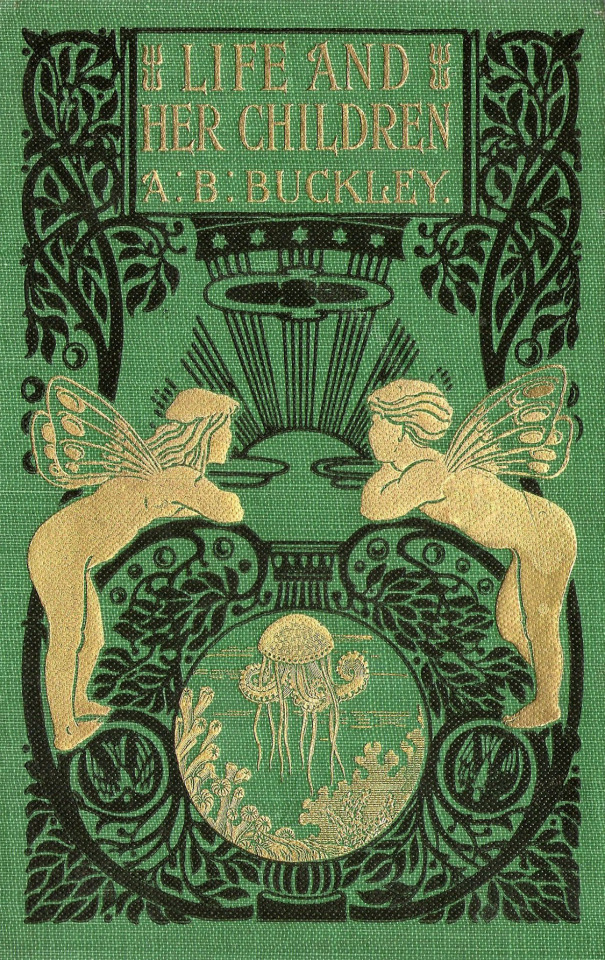
LIFE AND HER CHILDREN: Glimpses of Animal Life from the Amoeba to the Insects by A.B. Buckley (New York: Appleton, 1881). With upwards of one hundred illustrations.
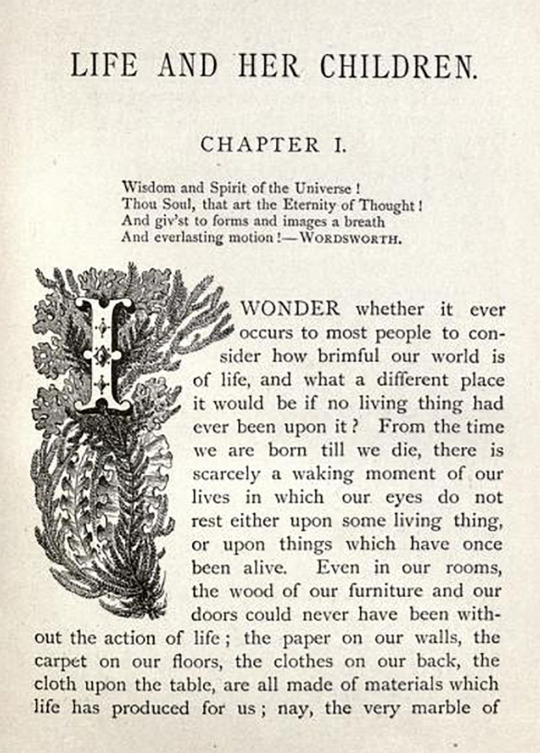

source [another edition]
#beautiful books#book blog#books books books#book cover#books#vintage books#illustrated book#victorian era#biology#insects#biodiversity#book design
93 notes
·
View notes
Text





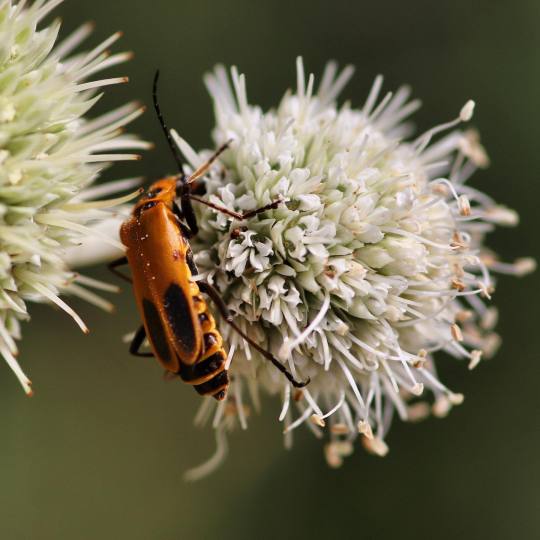

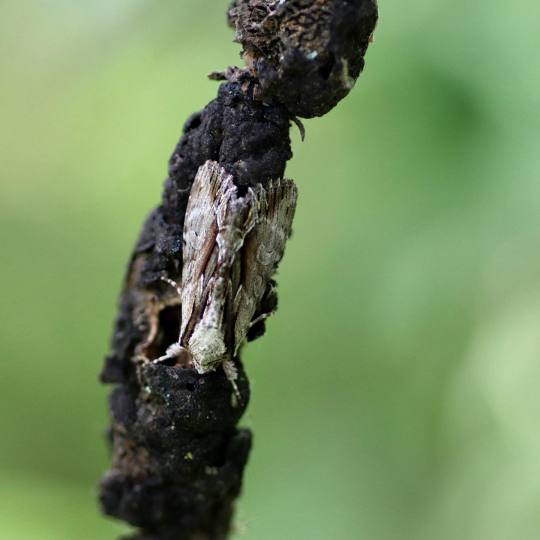


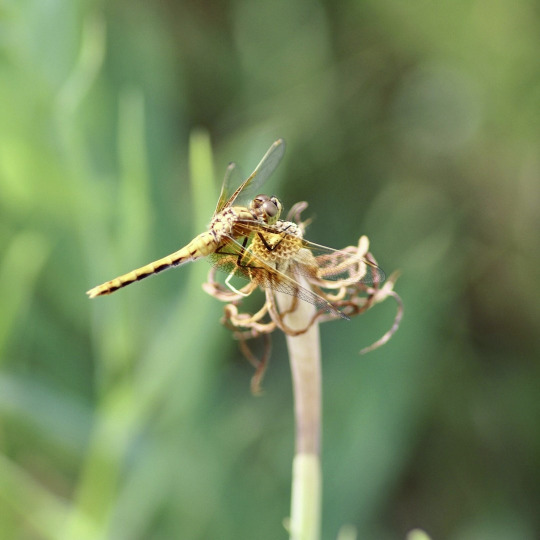

Some of the insects I photographed last summer.
#insects#moth#moths#beetle#beetles#butterfly#butterflies#bugs#naturalist#inaturalist#conservation#biodiversity#photography#macrophotography#bee#bees#insect art
63 notes
·
View notes
Text
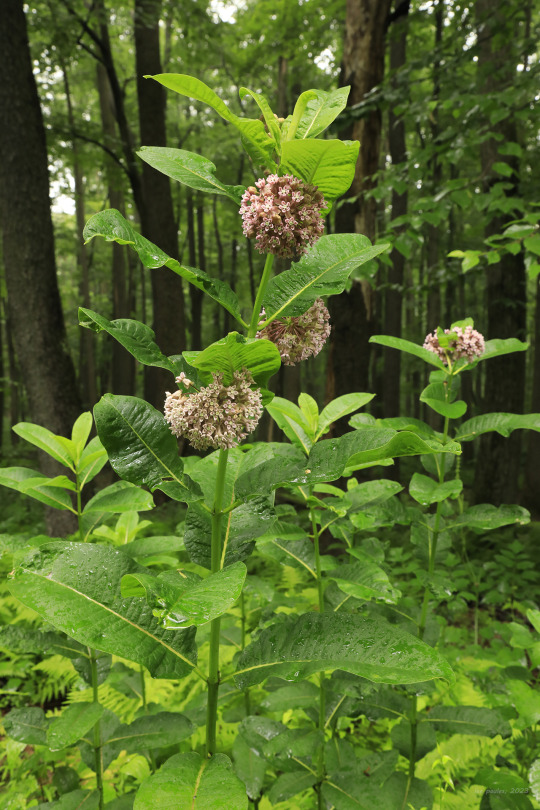

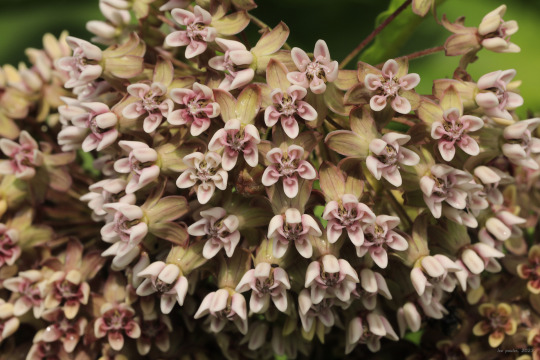

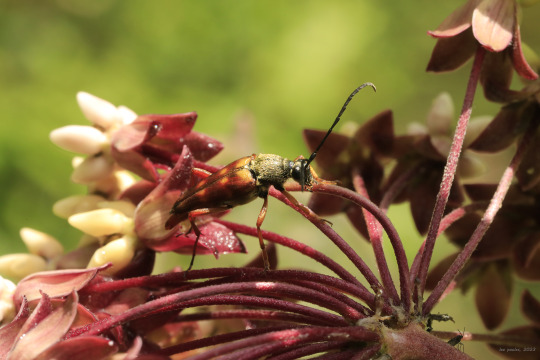
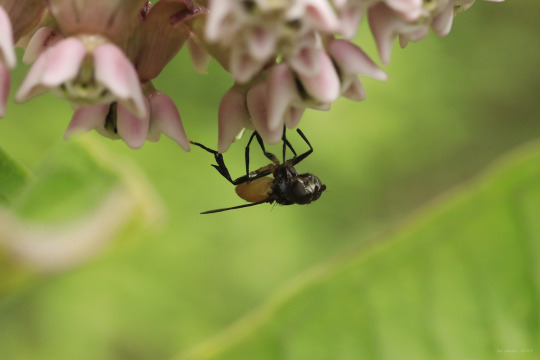
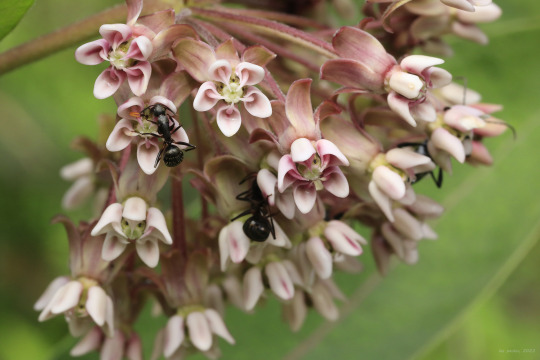
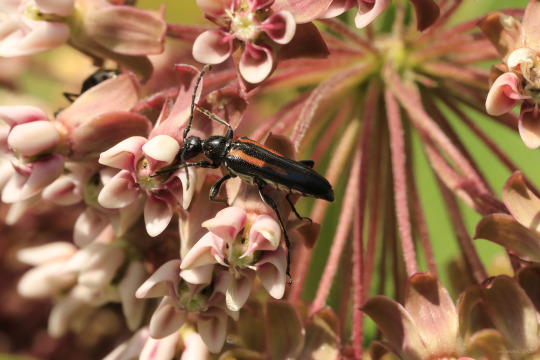

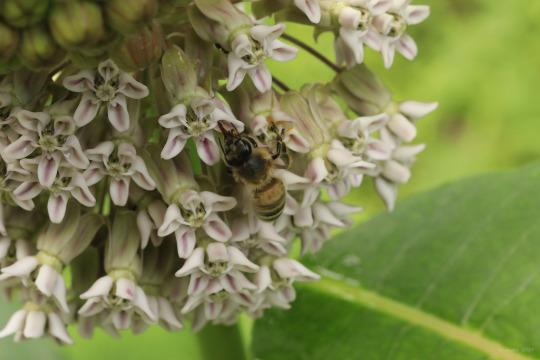
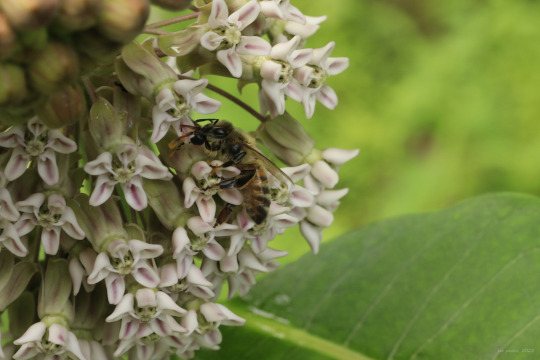

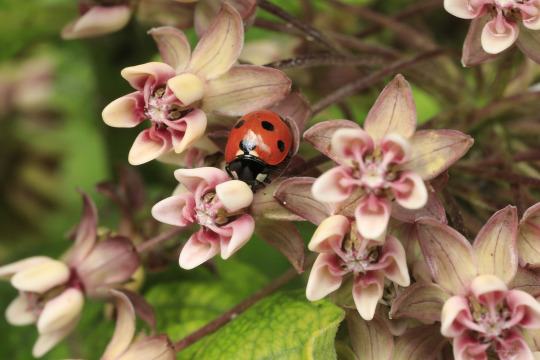


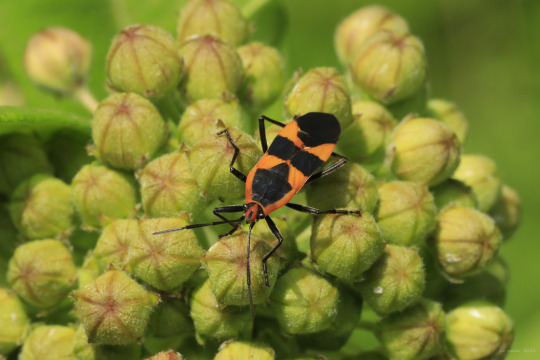
“In planning to be a professional naturalist….. I turned to the teeming small creatures that can be held between the thumb and forefinger, the little things that compose the foundations of our ecosystems, the little things that I like to say, run the world.”
Edward O. Wilson
By observing a milkweed plant very closely for more no more than five minutes, you will begin to understand exactly what Wilson was getting at.

#wildflowers#flora#appalachia#vandalia#west virginia#coopers rock state forest#summer#common milkweed#life#diversity#biodiversity#ecology#insects#the little things#life is beautiful#life is fragile#large milkweed bug#longhorn beetle#honeybee#milkweed weevil#seven-spotted ladybug#net-winged beetle#edward o. wilson#e. o. wilson
202 notes
·
View notes
Text
I love long, meadow-y grass so I don't mow my lawn. (Except the strip by the sidewalk, which is part of the public right-of-way.)
Today I discovered a ground nesting bird (a dark eyed junco) has built a nest on my yard, hidden by the long grass! Several little eggs in it.
#birds#dark eyed junco#even leaving a small portion of your yard unmowed will increase biodiversity#in the spring the early insects shelter in the long grass#in the summer the grass lays flat sheltering its roots and keeping them damp#in the fall the seeds develop on unmown grass#which the little birds eat#in the winter the old vegetation shelters plants and creatures from the cold#and the older vegetation biodegrades and renews the soil
37 notes
·
View notes
Text
heres your reminder that there are whole ecossystems in cities. theres microbes and fungi and plants and animals. and they form their own biological community and its all around us. and we often just brush them off as pests or lesser for not being the beings that we see in the wild, but theyre there! theyre thriving and fighting and building their own peculiar urban ecossystem. and how could you say they dont matter just because theyre not in the wild?
cities arent dead. theres life everywhere. theres life in the spiders and insects and birds. theres life in the mold and moss and flowers and trees. just look around you! nature is here! nature is alive!
21 notes
·
View notes
Note
are there insects that live in the sea or at least on its surface? as in not insect-equivalent arthropods like crustaceans and stuff but as in legit insects of the six legged variety
if you count mangroves and brackish environments, as well as seashores, there’s quite a few insects that live there. but there are very few that live on or in the ocean!
the most successful are the sea skaters (Halobates) and even only a few of these live on the open ocean, most being coastal. they are hemipterans in the same family as waterstriders, but smaller and differently shaped than their freshwater relatives. they hunt plankton and scavenge, laying eggs on floating debris.
another really bizarre one is a genus of flightless fly, Pontomyia. males have elongated appendages and swim by rowing their shrunken wings, while females are legless and larviform. they’re still fairly tied to shore I think but their larvae have been found living on sea turtle shells, hinting at their ability to spread across oceans this way!
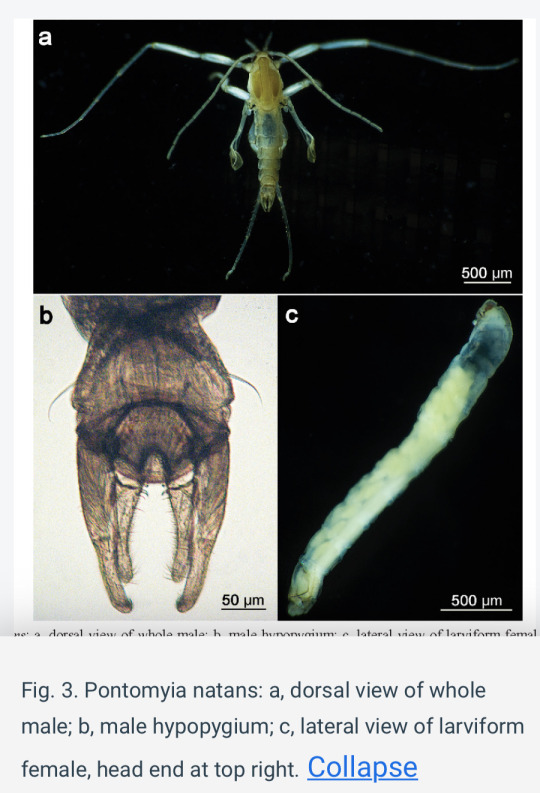
https://www.semanticscholar.org/paper/Discovery-of-the-flightless-marine-midge-Pontomyia-Cheng-Huang/792a66efd06891fab4055a3f3a94897723cf41f5
143 notes
·
View notes
Text
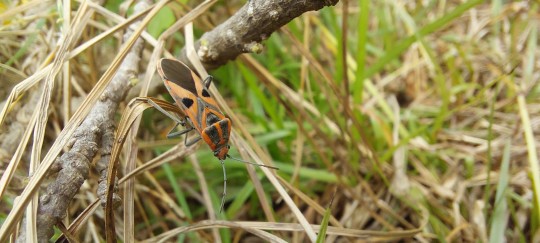
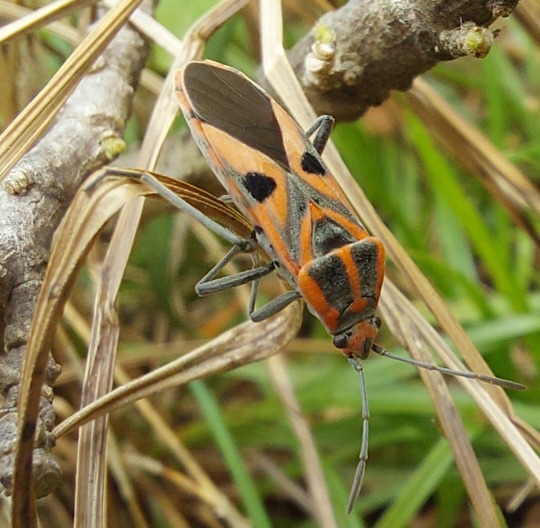

"𝑩𝒖𝒕 𝒕𝒉𝒆 𝒊𝒏𝒔𝒆𝒄𝒕-𝒘𝒐𝒓𝒍𝒅 𝒊𝒔 𝒂𝒍𝒕𝒐𝒈𝒆𝒕𝒉𝒆𝒓 𝒂 𝒘𝒐𝒓𝒍𝒅 𝒐𝒇 𝒈𝒐𝒃𝒍𝒊𝒏𝒔 𝒂𝒏𝒅 𝒇𝒂𝒊𝒓𝒊𝒆𝒔: 𝒄𝒓𝒆𝒂𝒕𝒖𝒓𝒆𝒔 𝒘𝒊𝒕𝒉 𝒐𝒓𝒈𝒂𝒏𝒔 𝒐𝒇 𝒘𝒉𝒊𝒄𝒉 𝒘𝒆 𝒄𝒂𝒏𝒏𝒐𝒕 𝒅𝒊𝒔𝒄𝒐𝒗𝒆𝒓 𝒕𝒉𝒆 𝒖𝒔𝒆, 𝒂𝒏𝒅 𝒔𝒆𝒏𝒔𝒆𝒔 𝒐𝒇 𝒘𝒉𝒊𝒄𝒉 𝒘𝒆 𝒄𝒂𝒏𝒏𝒐𝒕 𝒊𝒎𝒂𝒈𝒊𝒏𝒆 𝒕𝒉𝒆 𝒏𝒂𝒕𝒖𝒓𝒆; 𝒄𝒓𝒆𝒂𝒕𝒖𝒓𝒆𝒔 𝒘𝒊𝒕𝒉 𝒎𝒚𝒓𝒊𝒂𝒅𝒔 𝒐𝒇 𝒆𝒚𝒆𝒔, 𝒐𝒓 𝒘𝒊𝒕𝒉 𝒆𝒚𝒆𝒔 𝒊𝒏 𝒕𝒉𝒆𝒊𝒓 𝒃𝒂𝒄𝒌𝒔, 𝒐𝒓 𝒘𝒊𝒕𝒉 𝒆𝒚𝒆𝒔 𝒎𝒐𝒗𝒊𝒏𝒈 𝒂𝒃𝒐𝒖𝒕 𝒂𝒕 𝒕𝒉𝒆 𝒆𝒏𝒅𝒔 𝒐𝒇 𝒕𝒓𝒖𝒏𝒌𝒔 𝒂𝒏𝒅 𝒉𝒐𝒓𝒏𝒔; 𝒄𝒓𝒆𝒂𝒕𝒖𝒓𝒆𝒔 𝒘𝒊𝒕𝒉 𝒆𝒂𝒓𝒔 𝒊𝒏 𝒕𝒉𝒆𝒊𝒓 𝒍𝒆𝒈𝒔 𝒂𝒏𝒅 𝒃𝒆𝒍𝒍𝒊𝒆𝒔, 𝒐𝒓 𝒘𝒊𝒕𝒉 𝒃𝒓𝒂𝒊𝒏𝒔 𝒊𝒏 𝒕𝒉𝒆𝒊𝒓 𝒘𝒂𝒊𝒔𝒕𝒔! 𝑰𝒇 𝒔𝒐𝒎𝒆 𝒐𝒇 𝒕𝒉𝒆𝒎 𝒉𝒂𝒑𝒑𝒆𝒏 𝒕𝒐 𝒉𝒂𝒗𝒆 𝒗𝒐𝒊𝒄𝒆𝒔 𝒐𝒖𝒕𝒔𝒊𝒅𝒆 𝒐𝒇 𝒕𝒉𝒆𝒊𝒓 𝒃𝒐𝒅𝒊𝒆𝒔 𝒊𝒏𝒔𝒕𝒆𝒂𝒅 𝒐𝒇 𝒊𝒏𝒔𝒊𝒅𝒆, 𝒕𝒉𝒆 𝒇𝒂𝒄𝒕 𝒐𝒖𝒈𝒉𝒕 𝒏𝒐𝒕 𝒕𝒐 𝒔𝒖𝒓𝒑𝒓𝒊𝒔𝒆 𝒂𝒏𝒚𝒃𝒐𝒅𝒚".
-Lafcadio Hearn
𓆣ִ ࣪⋆⭒˚。⋆𖦹
Spilostethus furcula
𓋼𓍊𓆱𖢥𓍊𓋼𓍊𓋼𓍊𓋼𓍊
19/03/2024 (13:11 p.m.)
⋆⭒˚.⋆
#˗ˋˏ ♡ ˎˊ˗#bugs#insect#insects#macro#bugblr#entomology#nature#tumblr#ecology#biology#zoology#photos#conservation#biodiversity#naturalist#stunning#photography#naturecore#phtooftheday#macrophotography#tumblrphoto#original post#in the woods#into the woods#curators on tumblr#original photogrpahy#original photographers#artists on tumblr#photographers on tumblr
22 notes
·
View notes
Text

Kolam ikan
#invertefest#art#digital art#illustration#insect#biodiversity#urban nature#pond#indonesian artist#artistofsea
389 notes
·
View notes
